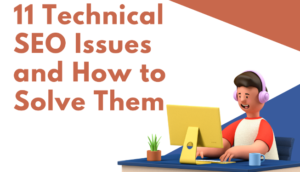For over a decade, Google has been working to clamp down on thin and low-quality content. Since the release of the Panda in 2011 and its subsequent updates, your website can’t rank if your content isn’t valuable.
Using sophisticated algorithms and constantly updating them, search engines have rewarded websites with high-quality content with ranking gains. At the same time, they’ve been penalizing sites that create blunt content and employ black hat SEO tactics by stopping them from appearing so prominently in search results.
Thin content can be detrimental to your SEO strategy and objectives. You can’t bring in organic traffic or achieve your content marketing goals if your content doesn’t rank. But why is that?
This article will explore what thin content is, how it can’t prevent you from ranking, and what you can do to avoid it. Read on.
What is Thin Content?
Thin content refers to content that Google considers to have little or no added value. The search engine flags such content preventing it from performing well on the search engine result pages (SERPs).
For your content to perform well in Google results, you need to make it valuable to the end user. This is achieved by answering their questions and providing solutions to their pain points.
The search engine giant invests heavily in its algorithm to ensure that content that ranks on its SERPs is high quality and helpful to searchers. Cutting corners to go around these algorithms often results in violating Google’s Webmaster guidelines.
So, what content that Google considers thin? In simple terms, any content meant to deceive users into clicking your links and content that is primarily made to beat algorithms instead of users.
Let’s look at some types of content that fall under this umbrella.
Examples of Thin Content
Search engines crawl billions of web pages to identify valuable content and push it up the SERPs. At the same time, it also identifies thin content and de-index sites they appear on, preventing them from appearing on SERPs.
If you want to ensure your website and webpages aren’t taken out of search engine ranking pages, steer clear of such practices when creating content.
Shallow Content
Shallow content isn’t necessarily short content but rather content that lacks depth and substance. Writing long-form articles doesn’t translate to quality content either. Short in-depth content of fewer than 1,000 words can rank higher than a 2,000-word article on the same subject if it offers the readers insights, a practical tip, and provides them value.
Shallow content has no direction. It’s often filled with superficial ideas and doesn’t inspire any actions. They show no expertise and are usually not written for users but to rank. Search engines can pick up on such content and keep them away from the SERPs.
To avoid shallowness when writing an article, make it argumentative, clarify your points with examples, back your arguments by quoting research and stats from reputable sources, and tell a story.
Additionally, structure your article using images, headings, subheadings, lists, etc. Such practices make your content more organised and appealing to users and search engines.
Syndicated Content
Content syndication involves pulling and scrapping content from a different website, sharing it on your site, and crediting the owners. It’s a practice mostly done by website owners who don’t have enough content for their sites or lack enough reach for content to achieve their goals.
Syndicating content can allow you to keep your audience engaged and drive traffic to your website. But in the long-term, it can hurt your SEO strategy as search engines consider them thin content. This is because Google will favour the website the content appeared on first, especially if it has higher domain authority. To prevent redundancy, your webpage will be de-indexed.
Instead of syndicating content on your website, you should do it on other platforms and generate backlinks to your site. Use platforms such as Medium, LinkedIn, and quora to share such content with your audience.
If you decide to publish them on your site, properly tag the content to direct Google crawlers to the original version or prevent it from being indexed in the first place.
Additionally, you should avoid plagiarism- copying content from other websites and passing them as your own. Your website could face a DMCA strike which could prevent your content from appearing on search results.
AI-generated Content
While AI-generated content has improved over the last few years, Google algorithms have also gotten smarter. This machine learning software can generate articles about any subject in a few clicks, help you paraphrase other pieces, and assist you in translating content from different languages.
If you use AI to generate content, ensure you use the best ones in the industry. And before you publish it and prevent it from falling in the thin content category, run it by an editor. Let them give it a personal touch that can inspire readers.
Low-Quality Affiliate Content
Affiliate marketing is one of the most common ways content creators earn through their websites, especially when they don’t have any products to sell. When done right, it allows you to create comprehensive purchasing advice for the site, and you won’t risk a search penalty.
You only have a reason to worry when you fill your content with countless affiliate links meant to deceive users and offer no valuable information.
Getting around this is easy. Only promote products relevant to your audience and when you add affiliate links, let them fit naturally in your content. If you have web pages dedicated to this, ensure they’re high-quality and up-to-date. Finally, once an affiliate link expires, ensure you remove it from your website.
Using Doorway Pages
This is the practice of spamming SERPs with thin content targeting specific keywords to redirect traffic to another website. Often, it means the user ends up with low-quality content, and to get the relevant information they’re searching for, they have to leave to go to another destination.
This practice creates a poor user search experience and makes it cumbersome to get the desired results. To avoid this, search engines make it hard for websites that use this practice to rank.
When creating content, always ensure you address your audience’s main pain points in the article. Avoid redirecting them to other pages. And if you have to do it, naturally hyperlink your resources by avoiding practices like “click here” or “learn more” when redirecting traffic.
How Thin Content Can Hurt Your SEO
The apparent risk you face when you publish thin articles will come from Google and other search engines. They’ll hit you with search penalties and deindex your website, preventing them from ranking hence blocking your chances of getting organic traffic.
But before Google picks up on your thin content, your audience will see it immediately when they visit your site. And this will drive them away, and in the long run, they’ll associate your domain with low-quality content.
Here are some ways thin content can affect your SEO and hurt your marketing objectives.
Affects Your Website Authority
When a user visits your page two or three times and doesn’t get the help they want, you will likely not see them again. That’s because when a person reads your article, they can form an opinion about you, the writer. Depending on how thin your content is, they can tell whether they should trust you or not.
This is why you must aim to create authoritative content that can:
- Inform the reader by answering their query
- Demonstrates high-level expertise
- Provides the right level of depth
- Educates the audience and gives practical solutions
- Persuades the reader to take action
If you can’t develop a relationship with your audience, they can’t trust you, which means they won’t be visiting your website anymore. And when thin content prevents you from being authoritative, your SEO strategies will backfire.
Google Can De-Index Your Website
You know that feeling when you search for something and click on a link, only to be greeted by shallow content? If you do, it is an experience you don’t wish to subject to your audience. Quality is vital not just for your audience but for your SEO. When you publish content that doesn’t meet the needs of your readers, Google will notice it and penalize you by deindexing your website.
Google’s quality algorithms never take a break. So when you notice that your pages are dropping in the SERPs, the algorithm is convinced your content isn’t the most appealing to users. And the ranking will only decrease unless you take action.
When indexing and ranking content, Google considers your whole website, so it doesn’t matter whether you have 100s or high-quality content. If the algorithm notices 20 thin articles, you are in hot soup.
Search engines will try to index all the pages on your website to account for your overall site quality. But not all pages need to be indexed. Landing pages for ads, your admin pages, the privacy policy pages, outdated content, and duplicate pages can all affect your SEO if they are indexed. You must get ahead of them by de-indexing them. This will prevent the algorithms from taking them into account when gauging your website content quality.
It Will Cause Keyword Cannibalization
Keyword cannibalization happens when two or more pages on your website fight to rank for the same keyword. When search engine bots crawl your site and notice this, they’ll have problems deciding which page to prioritize. As a result, the wrong page ranks, or you don’t rank at all for being redundant.
Consider this article; keyword cannibalization would happen if I created three short blog posts instead of writing one long piece about thin content. I’d have one covering what thin content is, another dissecting different examples of thin content, and a third about how to avoid it. I’d end up with three web pages discussing the same topic, which could hurt my ranking efforts.
So instead of writing three short and thin 700-word articles covering the same subject, combine them and publish them as one post. This won’t not only allow you to provide more value to your readers, but your content will also be attractive to search engines.
Avoid Creating Thin Content
For your content to rank and ensure you achieve your content marketing goals, you must avoid creating thin content. Here are some steps to ensure your website and article never miss from SERPs.
- Have Content Strategy: Don’t just publish an article for the sake of publishing. Define your goals and create content that will satisfy your audience while also ensuring you reap the benefits, whether it is building awareness for your brand or selling a product. Without a predefined strategy, your content will get lost in the noise, and search engines will ignore it.
- Be Authoritative: Ensure your content stands out from competitors by publishing highly researched, original lengthy articles, whitepapers, and case studies and backing up your claims with verifiable data. You will rank higher, and your audience will learn to trust you.
- Avoid Hard Sells: Be subtle with your pitches, whether you are doing affiliate marketing or selling your own products. Create content that makes the user want to make a purchase or take action without feeling forced.
- SEO Tactics: The search engine algorithms will notice any black hat SEO practices you employ in your content to rank higher, whether it’s keyword stuffing or hijacking. Follow the best SEO practices and create content for humans instead of Google.
Website UI: Your website UI plays a significant role in helping you rank. If it’s slow, complicated, and not user-friendly, you won’t be able to retain your reader, and that might lead to your site being deindexed.
Identify and Fix Thin Content
The best way to identify and fix thin content is to have a content audit before and after publishing. Ensure you are creating high-quality content that will be helpful to the readers first; let ranking take a second seat. Only through this can you incorporate all the best SEO practices in your content. If you try to beat the algorithm, the results will be short-lived, as you’ll be discovered in no time and get penalized.
And once your content is live, constantly assess its performance and update it whenever necessary. This includes getting rid of expired affiliate links, using 301 redirects to send users to other destinations, and employing canonical tags that tell Google which page to index. Finally, you should also consider deleting outdated content that isn’t beneficial to your users.





